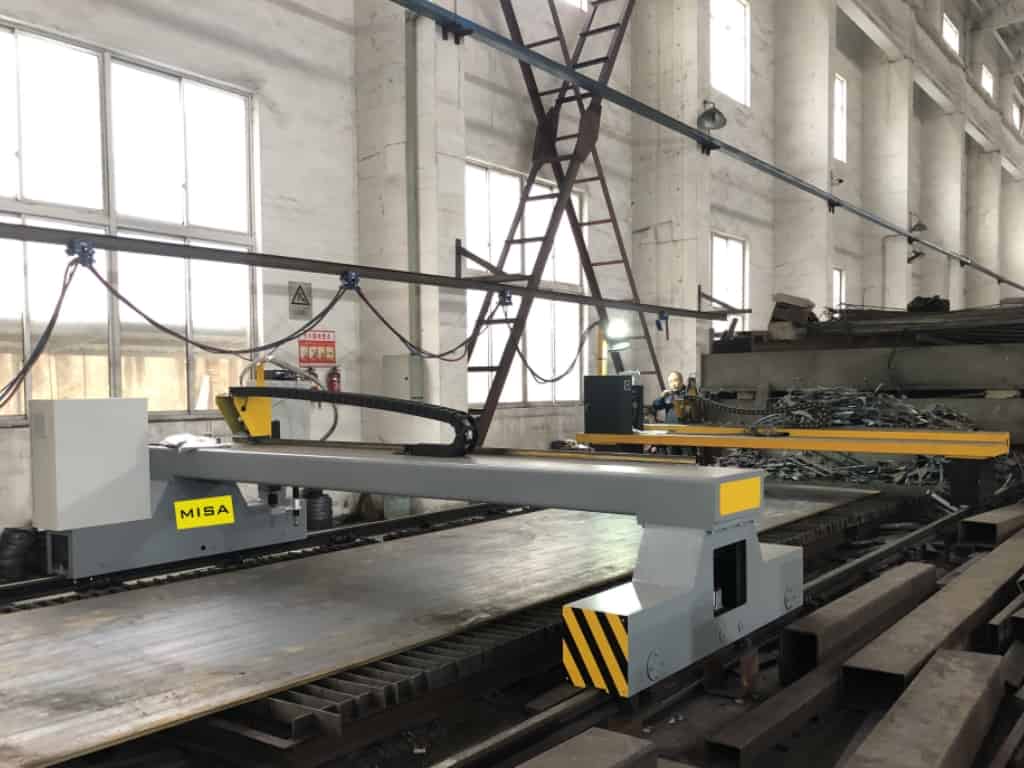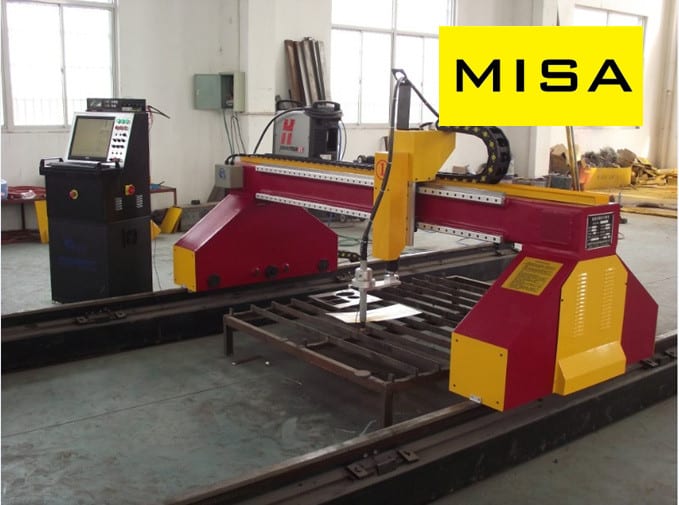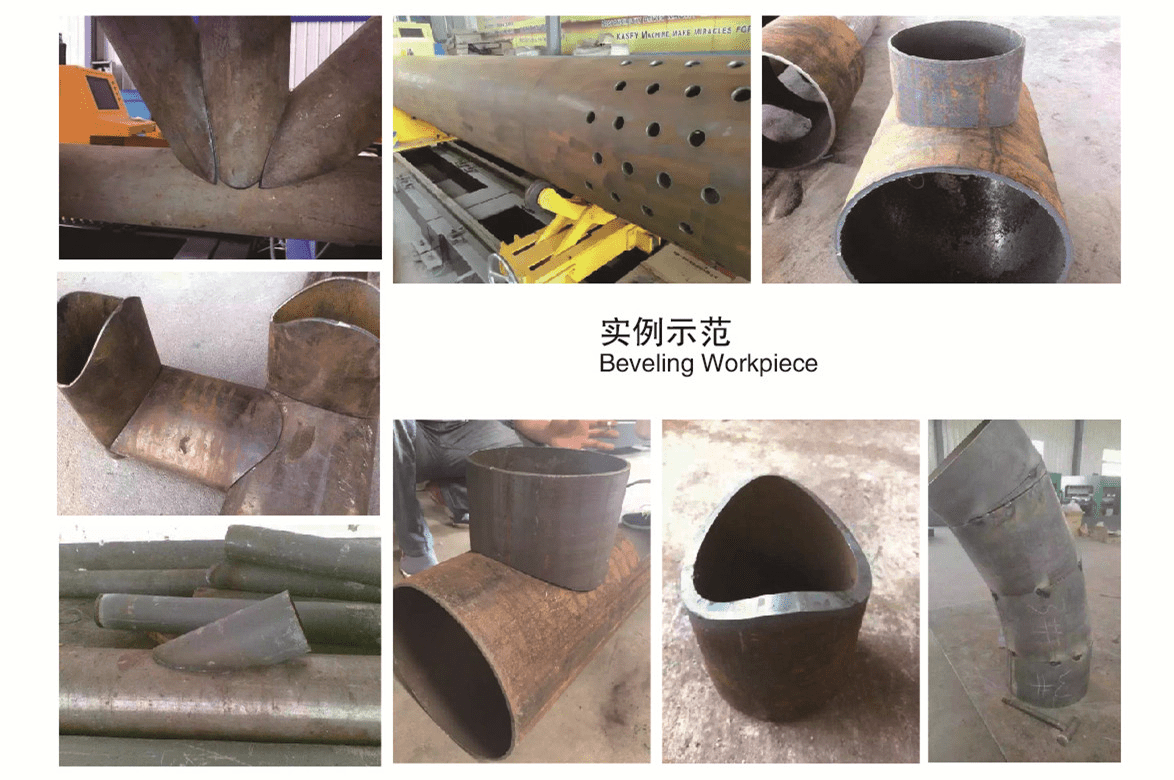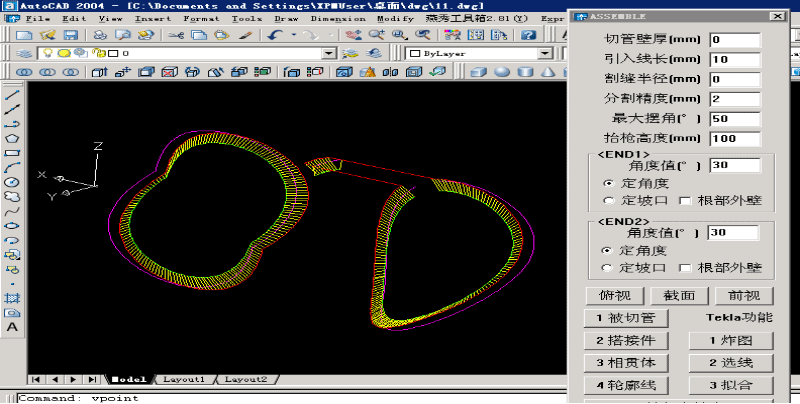

5 Axis CNC Flame Plasma Cutting Machine Q235 Material For Steel Pipes Fabrication

Quick Details:
- Type:CNC Pipe Cutting Machine
- Brand:MISA
- Condition:100% brand new
- Model number:CNC 50-800
- Place of origin:Wuxi China(Mainland)
- Usage: Cutting hole, Hole beveling, Intersecting line cutting
- Voltage:110V-600V
- Color:Yellow/Blue/Grey/Red/Customized
- Dimensions and
- weight:According to the model
Brief Description:
CNC 50-800 series numerical control pipe intersecting line cutting machine is a kind of equipment for automatic calculation and cut off at the end of steel pipe. The machine can be widely used in shipbuilding, construction, petrochemical, machinery, metallurgy and other industries of the pipeline structure cutting process. There are a large number of pipes with intersecting line hole, intersecting line ends in these industries, also commonly known as “small shrimp section” of the elbow; this kind of processing in most production is using making sample, marking, manual lofting, manual cutting, manual polishing backward, complicated method. QGVI series CNC pipe cutting machine produced in our factory is very convenient to cut such artifacts, and workers without programming, only need to input the matched radius and the intersection angle parameters of the tube, the machine will automatically cut the pipe intersecting lines and intersecting holes, and the welding groove, does not need manual polishing.
Kindly Noted:
1. Diameter from 50-2600mm, others size please confirmed with us.
2. One set of welding turning rolls include one drive & one idler, also customer can choose other combinations.
3. Voltage standard is 380V , 50HZ , 3PH. Other voltage please kindly let us know.
4. Control panel is wired control ,or you can choose wireless control.
5. If customers need more special requirements ,we’ll study with our engineer.
6. Color of the machine is according to the customers.
Technical Parameters:
No. | cnc pipe cutting machine | Parameters |
1 | Cutting diameter | 1. Φ= round : 50mm~800mm , |
2 | Cutting method | Plasma / Flame |
3 | Plasma power brand | Hypertherm 105A/125A/200A |
5 | Plasma cutting wall thickness | According to plasma power source |
6 | Flame cutting wall thickness | 1.Vertical cutting 6-60mm |
7 | Plasma cutting thickness | HPR 105A 1.vertial cutting 1-20mm |
8 | Plasma cutting thickness | ≤25 |
9 | Requirements of the workpiece ovality | ≤1% |
10 | Cutting speed | 10~2000mm/min |
11 | Move speed | 10~6000 mm/min |
12 | Axial swing angle of cutting torch | α=±45° |
13 | For maximum weight cut tube | 5000Kg to 7500kg |
Brand using:
﹡ Software is made by HELIDIGI
﹡ Servo Motor Brand is Panasonic
﹡ Electrical Element is made by Schneider /Siemens
﹡ Wireless Control box is made by Taiwan by Yuding
﹡ Bearing is made by NTN / Harbin
﹡ Gearbox is made by Neugart
﹡ Plasma Power source is made by Hypertherm
﹡ Cutting Torch is made by Messer


Mastering Precision in Metal Fabrication: A Comprehensive Guide to Plasma Cutting Machines
Meta Description: Dive into the world of precision metal cutting with our guide on plasma cutting machines. Uncover the fundamentals, advantages, and limitations of this cutting-edge tool, revolutionizing industries from metal fabrication shops to aerospace. Whether you’re a novice or a seasoned professional, discover the intricacies, applications, and safety measures to unleash the full potential of plasma cutting for both small-scale workshops and heavy-duty industrial processes.
Introduction:
In the intricate realm of metal fabrication, precision is paramount, and advancements in technology continually reshape the landscape. One such revolutionary tool that has left an indelible mark on the industry is the plasma cutting machine. As the heartbeat of modern metalworking, these cutting-edge devices have transformed metal fabrication shops, playing a pivotal role in aerospace and heavy-duty industrial processes alike.
Whether you’re a newcomer seeking to grasp the fundamentals or a seasoned professional looking to enhance your skills, our comprehensive guide is your gateway to unraveling the intricacies of this powerful tool. Join us as we delve into the essentials, explore the advantages, navigate the limitations, and uncover the diverse applications of plasma cutting, all while prioritizing safety measures to ensure a seamless integration into both small-scale workshops and large-scale industrial endeavors. Embark on a journey to unleash the full potential of plasma cutting and elevate your metal fabrication expertise.
What is a Plasma Cutting Machine?
A Plasma Cutting Machine stands at the forefront of modern metalworking technology, revolutionizing precision cutting in the machine industry. Employing the power of ionized gas, or plasma, this advanced tool generates a high-temperature electrical arc capable of slicing through a diverse range of conductive materials with unparalleled precision. In stark contrast to conventional cutting methods, plasma cutting machines offer superior speed, efficiency, and accuracy, making them indispensable in a myriad of industries.
Their versatility extends from small-scale workshops to massive industrial operations, where intricate metal shapes and designs are required. The utilization of plasma in metal cutting not only enhances efficiency but also allows for cleaner cuts, reducing the need for extensive post-processing. As a result, plasma cutting machines have become an integral part of the modern manufacturing landscape, exemplifying the relentless pursuit of innovation in the machine industry.
How Does a Plasma Cutting Machine Work?
Plasma cutting operates on the principles of thermodynamics and electrical conductivity. The machine generates a high-velocity jet of ionized gas, forming plasma, by passing an electrical arc through it. This superheated plasma, directed through a constricting nozzle, swiftly melts and blows away the material, creating a precise cut.
- Ionization: The process begins by ionizing the gas, typically compressed air or inert gases, creating a conductive path for the electrical arc.
- Arc Formation: An electrical arc is established between the electrode and the workpiece, resulting in the formation of plasma.
- Plasma Jet: The plasma, accelerated through a focused nozzle, reaches extreme temperatures, melting and expelling the material.
Main Components of a Plasma Cutting Machine:
In the realm of the machine industry, a fundamental understanding of plasma cutting machines is essential for anyone involved in metal fabrication or manufacturing processes. These machines leverage the principles of plasma physics to cut through various metals with precision and efficiency. Let’s delve into the main components that constitute a plasma cutting machine:
- Power Supply:
- Function: The power supply serves as the heart of the plasma cutting process, generating the electrical arc necessary for the formation of plasma.
- Key Role: Converts electrical energy into a high-voltage, high-frequency output, initiating the ionization of gas to form plasma.
- Plasma Torch:
- Components: Housed within the plasma torch are the electrode and nozzle, crucial elements for the creation and direction of plasma.
- Operation: The electrode initiates the arc, while the nozzle focuses and directs the plasma stream onto the metal surface, facilitating efficient cutting.
- Gas Supply:
- Importance: The gas supply system is integral for providing the gases required for ionization and the subsequent formation of plasma.
- Gases Used: Typically involves a combination of inert and reactive gases, such as argon and hydrogen, creating an environment conducive to plasma generation.
- Controller:
- Role: The controller acts as the brain of the plasma cutting machine, orchestrating the movement of the cutting head along the programmed path.
- Precision: Ensures accuracy and precision in the cutting process by managing the speed, direction, and other parameters of the cutting head’s movement.
Having a grasp of these key components empowers individuals in the machine industry to optimize the performance of plasma cutting machines, resulting in efficient and high-quality metal cutting for a diverse range of applications.
Advantages of Using a Plasma Cutting Machine:
Investing in a plasma cutting machine in the machine industry offers a range of advantages that contribute to enhanced safety, efficiency, and overall cost-effectiveness. One of the primary benefits is the heightened safety it brings to the table, significantly reducing the risk of accidents when compared to traditional cutting methods. The versatility of plasma cutting machines is a key highlight, as they are capable of effortlessly cutting through a variety of materials, ranging from metals to non-ferrous materials.
Speed is another major advantage, as these machines boast faster cutting speeds compared to many alternative methods, contributing to increased productivity. Precision is a hallmark feature, enabling high levels of accuracy and intricate detailing capabilities, making them suitable for a wide array of applications. Moreover, the cost-effectiveness of plasma cutting machines is notable, especially when compared to laser cutting machines, making them a more accessible option for businesses. Lastly, the portability of these machines adds to their appeal, as they can be used efficiently in both small-scale workshops and large industrial settings, providing flexibility and convenience in various operational environments.
Limitations or Restrictions on Material Thickness:
Plasma cutting, a versatile technique widely employed in the machine industry, exhibits certain limitations, especially concerning material thickness. Understanding these constraints is crucial for optimal utilization:
- Thin Materials: Plasma cutting proves highly effective and precise when applied to thin sheets and materials of medium thickness. Its ability to deliver clean, accurate cuts in these scenarios makes it a preferred method for intricate designs and detailed work.
- Limited Thickness: Despite its versatility, plasma cutting encounters challenges when tasked with extremely thick materials. While it excels in the thin to medium thickness range, alternative cutting methods may be more suitable for heavy-duty applications. Users should carefully evaluate the material specifications and project requirements before opting for plasma cutting, considering the limitations in thickness.
- Consideration of Material Type: The effectiveness of plasma cutting is also influenced by the type of material being processed. While it excels with conductive materials like steel, aluminum, and copper, it may encounter difficulties with certain non-conductive materials. Understanding the compatibility of plasma cutting with specific materials is pivotal for achieving optimal results in various industrial applications.
Differences from Other Cutting Methods:
Plasma cutting stands out among various cutting methods, such as laser cutting and waterjet cutting, due to its unique characteristics. Understanding these differences is essential for industries seeking optimal cutting solutions.
- Cutting Mechanism:
- Plasma Cutting: Involves the use of ionized gas (plasma) to melt and expel material from the workpiece. The plasma is created by an electrical arc passing through a gas like nitrogen or oxygen.
- Laser Cutting: Utilizes a focused laser beam to melt or vaporize material, resulting in precise and clean cuts. It is particularly effective for intricate designs.
- Waterjet Cutting: Deploys a high-pressure waterjet mixed with abrasive materials (such as garnet) to erode and cut through materials. This method is versatile and suitable for a wide range of materials.
- Material Compatibility:
- Plasma Cutting: Well-suited for conductive materials like steel, aluminum, and stainless steel. It excels in cutting thick materials.
- Laser Cutting: Ideal for a variety of materials, including metals, plastics, wood, and ceramics. However, its effectiveness can be limited for highly reflective or transparent materials.
- Waterjet Cutting: Versatile, capable of cutting through metals, composites, glass, stone, and more. It is especially useful for materials that may be sensitive to heat.
- Cutting Speed and Precision:
- Plasma Cutting: Generally faster than traditional methods and can handle thick materials efficiently. It may have slightly lower precision compared to laser cutting.
- Laser Cutting: Offers high precision, making it suitable for intricate patterns and fine details. The cutting speed is influenced by material thickness.
- Waterjet Cutting: Known for its precision and ability to produce intricate cuts without heat-affected zones. However, it tends to have a slower cutting speed compared to plasma and laser cutting.
- Cost Considerations:
- Plasma Cutting: Often considered a cost-effective solution, particularly for thicker materials.
- Laser Cutting: May have higher initial equipment costs, but it can be cost-effective for certain applications due to its speed and precision.
- Waterjet Cutting: Typically involves higher operating costs due to abrasive materials and maintenance requirements.
Typical Cost Range for a Plasma Cutting Machine:
Plasma cutting machines are integral tools in the modern machine industry, offering efficient and precise metal cutting solutions. The cost of these machines is influenced by various factors, primarily their specifications and capabilities. There are two main categories of plasma cutting machines: manual and automatic.
- Manual Machines:
- Cost Range: $2,000 to $3,000.
- Manual plasma cutting machines are more affordable, making them suitable for smaller workshops or businesses with lower production demands.
- They require skilled operators to guide the cutting process manually, offering flexibility in intricate designs and smaller-scale projects.
- Ideal for businesses with a limited budget or those focusing on custom, one-off projects.
- Automatic Machines:
- Cost Range: $8,000 to $12,000, with high-end models reaching $25,000.
- Automatic plasma cutting machines are a higher investment due to their advanced features and automation capabilities.
- Suitable for large-scale production environments where precision and speed are crucial.
- These machines are equipped with CNC (Computer Numerical Control) systems, allowing for automated and programmable cutting processes.
- Higher-end models offer additional features such as improved cutting speeds, multi-axis cutting, and enhanced software integration.
- Reduced reliance on skilled operators, increasing overall efficiency and output.
When considering a plasma cutting machine, businesses should evaluate their production needs, project scale, and budget constraints to choose the most appropriate machine for their specific requirements. Additionally, ongoing maintenance costs, consumables, and potential training for operators should be factored into the overall investment decision.
Industries Commonly Using Plasma Cutting Machines:
Plasma cutting machines have evolved into indispensable tools across a spectrum of industries, proving their versatility and efficiency in diverse applications.
- Metal Fabrication Shops:
- Plasma cutting finds extensive use in metal fabrication shops, where precision and speed are paramount. These machines excel in cutting through various metals, allowing for the creation of intricate designs and precise components.
- Automotive Manufacturing:
- In the automotive industry, plasma cutting machines contribute significantly to the production of vehicle components. They facilitate the precise shaping of metal sheets, ensuring high-quality and accurately sized parts for vehicles.
- Shipbuilding:
- Plasma cutting plays a crucial role in shipbuilding, allowing for the efficient fabrication of intricate components such as hulls and structural elements. The speed and precision offered by these machines contribute to the timely and accurate assembly of marine vessels.
- Construction:
- In the construction sector, plasma cutting machines are employed for the fabrication of structural elements, beams, and other metal components. Their ability to cut through thick metal with precision makes them invaluable in the construction of robust and reliable structures.
- Aerospace Industry:
- Aerospace manufacturing demands high precision and quality, and plasma cutting machines meet these requirements. These machines are utilized for cutting complex shapes and parts in the production of aircraft components, ensuring adherence to stringent aerospace standards.
- Art and Sculpture Creation:
- Beyond heavy industries, plasma cutting machines have found a niche in the realm of art and sculpture creation. Artists leverage these machines to transform metal sheets into intricate and unique sculptures, showcasing the artistic potential of this technology.
Safety Precautions When Operating a Plasma Cutting Machine:
Operating a plasma cutting machine requires strict adherence to safety precautions to mitigate potential risks and ensure a secure working environment. First and foremost, individuals operating these machines must prioritize the use of protective gear. This includes wearing suitable eye protection, such as welding goggles or face shields, to shield the eyes from intense light and potential debris. Additionally, flame-resistant clothing is essential to safeguard against sparks and heat generated during the cutting process.
Ventilation is a critical aspect of safety in plasma cutting. Working in well-ventilated areas helps disperse harmful fumes produced during the cutting process. If working indoors or in confined spaces, it is advisable to implement exhaust systems that effectively remove and filter out these fumes, preventing operators from inhaling hazardous substances.
Comprehensive training for machine operators is indispensable. Operators should undergo thorough training sessions covering both the technical aspects of the plasma cutting machine and the safety protocols associated with its operation. Training should emphasize proper machine setup, correct handling of materials, and emergency procedures. This knowledge equips operators with the skills to respond effectively to potential risks and emergencies, reducing the likelihood of accidents and ensuring a safer workplace. By combining these safety measures, individuals can confidently and securely operate plasma cutting machines, contributing to a more secure and productive work environment.
Types of Gases Used:
Understanding the types of gases used in processes like plasma cutting is crucial for optimizing efficiency and achieving high-quality results. Two primary categories of gases employed in plasma cutting include compressed air and inert gases.
- Compressed Air:
- General-purpose Cutting: Compressed air stands out as a widely utilized gas for its versatility in general-purpose cutting applications. It is readily available and cost-effective, making it a popular choice for various industries.
- Effective Heat Transfer: Compressed air facilitates effective heat transfer during the cutting process, allowing for precise and efficient material removal.
- Inert Gases (e.g., Argon, Nitrogen):
- Material-specific Applications: Inert gases such as argon, nitrogen, or their mixtures are chosen based on the specific materials being processed. This tailored approach enhances the cutting performance and quality.
- Reduced Oxidation: Inert gases are particularly beneficial when cutting materials sensitive to oxidation, as they create an oxygen-free environment. This prevents the formation of oxides on the cut edges, preserving the material’s integrity.
- Enhanced Precision: The use of inert gases is often preferred for intricate cutting tasks, contributing to improved precision and minimizing the need for post-cutting cleanup.
Maintenance and Care for a Plasma Cutting Machine:
Maintaining a plasma cutting machine is crucial for maximizing its lifespan and efficiency. Regular upkeep involves a combination of cleanliness, electrode inspection, and gas system checks to ensure optimal performance.
- Cleanliness: Keeping the machine and its components clean from debris and metal shavings is essential. Accumulated dirt can hinder the machine’s functionality and lead to premature wear and tear. Regularly wipe down the cutting table, remove any metal scraps, and clean the torch to prevent contamination.
- Electrode Inspection: The electrodes in a plasma cutting machine are integral to the cutting process. Regularly inspect these consumables for signs of wear, damage, or deterioration. Replace electrodes as soon as they show signs of degradation to maintain precise and efficient cutting. This proactive approach prevents poor cuts and minimizes the risk of damage to other components.
- Gas System Check: Ensure that the gas supply is both adequate and free from impurities. Inadequate gas flow can result in poor cut quality, while impurities in the gas can negatively impact the machine’s components. Regularly inspect the gas lines, filters, and regulators to guarantee a consistent and clean gas supply. Address any issues promptly to avoid disruptions in the cutting process.
By incorporating these maintenance practices into your routine, you not only extend the life of your plasma cutting machine but also ensure that it operates at peak performance, delivering high-quality cuts consistently.
Conclusion
In summary, the advent of plasma cutting machines has revolutionized the field of metal fabrication, emerging as indispensable tools across various industries. This guide unravels the intricacies of plasma cutting, providing insights into its principles, advantages, limitations, and applications. From enhancing skills for professionals to introducing basics for novices, the guide serves as a gateway to mastering plasma cutting’s potential.
The machines’ prowess in industries like automotive, shipbuilding, and aerospace is highlighted, emphasizing their speed, precision, and cost-effectiveness. While acknowledging benefits like safety and efficiency, the guide also explores limitations, enabling informed decision-making. Distinctions from other cutting methods are outlined, empowering industries to choose based on specific requirements. Financial considerations, safety precautions, and maintenance tips are addressed, emphasizing the importance of creating a secure working environment. Ultimately, this guide aims to empower the machine industry to unlock the full potential of plasma cutting, recognizing it as a key skill in the evolving landscape of metalworking.
Contents
- 5 Axis CNC Flame Plasma Cutting Machine Q235 Material For Steel Pipes Fabrication
- Mastering Precision in Metal Fabrication: A Comprehensive Guide to Plasma Cutting Machines
- Introduction:
- What is a Plasma Cutting Machine?
- How Does a Plasma Cutting Machine Work?
- Main Components of a Plasma Cutting Machine:
- Advantages of Using a Plasma Cutting Machine:
- Limitations or Restrictions on Material Thickness:
- Differences from Other Cutting Methods:
- Typical Cost Range for a Plasma Cutting Machine:
- Industries Commonly Using Plasma Cutting Machines:
- Safety Precautions When Operating a Plasma Cutting Machine:
- Types of Gases Used:
- Maintenance and Care for a Plasma Cutting Machine:
- Conclusion
